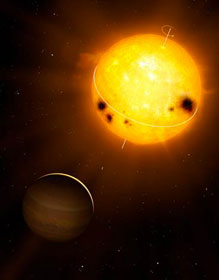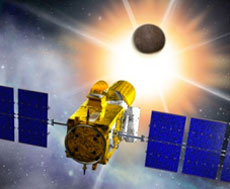
HD52265 is a G0V type main sequence star associated with a planet which was found through variations in the stellar radial velocity (Butler RP et al. 2000, Astrophys J 545, 504).
Data obtained with CoRoT was compared with a set of standard stellar models : in this way, the star HD52265 was identified as having a mass M= 1.27 +/-0.03 MSun, a radius R=1.34 +/- 0.02 RSun, and an age of A=2.37 +/-0.39 Gy. This study has also enabled an estimate of its mean internal rotation to be made : Ω/ΩSun=2.31 +0.45/-0.69, as well as the inclination of its rotational axis i=36 +15/-10 degrés with respect to the line of sight. In addition, the surface rotation was assessed from the light curve of HD52265, which bears witness to the presence of spots, and suggests that the rotation varies with latitude.
This information has in turn enabled the planet HD52265b to be identified as a typical case of a « hot Jupiter », i.e. a massive planet in a tight orbit around its star.
This data has given a precise impression of the observed system, in good agreement with other available sources of information. They have enabled a reanalysis of the planet HD52265b to be made, and to delimit its mass.
Neverthelees, the inclination of the orbital plane is still unknown, since the planet was found using the radial velocity technique and not via transits. Assuming that the planetary orbit is in the rotational plane of HD52265, this data gives for the mass of the planet HD52265b Mp= 1.85+0.52/-0.42 MJupiter.
With a semimajor axis of 0.504+/-0.029 UA, obtained from measurements of the stellar radial velocity, HD52265b seems to be well and truly a hot Jupiter : our solar system has no such objects, whose existence and relative frequency were revealed as a byproduct of exoplanet research. To understand how such planets can form, it has been necessary to develop fundamentally new models, in which the developing planets migrate through the protoplanetary disc.

This research builds on the work sparked by the CoRoT and Kepler prçjects, which highlight the importance of studying in a global way star-planet systems, not only in order to identify their components in a precise way, but also in order to better understand their interactions. This approach is the guideline of the PLATO project, which has been submitted to ESA.
The space mission CoRoT was developed and operated by the Centre National d’Etudes Spatiales, with contributions from Austria, Belgium, Brazil, the European Space Agency (Research and Scientific Support Department and Science Programme), Germany and Spain
